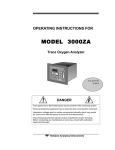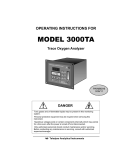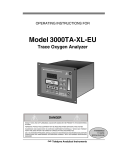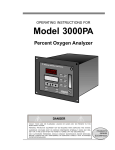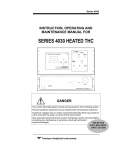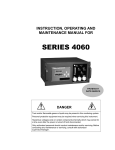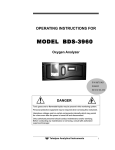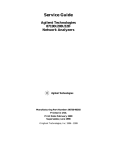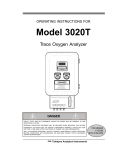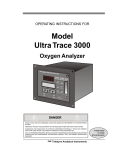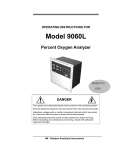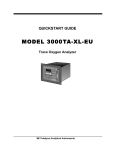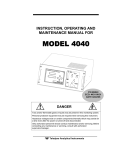Download Teledyne 3000ZA-3X Oxygen Equipment User Manual
Transcript
Trace Oxygen Analyzer OPERATING INSTRUCTIONS FOR MODEL 3000ZA-3X Trace Oxygen Analyzer P/N M77579 11/29/11 DANGER Toxic gases and or flammable liquids may be present in this monitoring system. Personal protective equipment may be required when servicing this instrument. Hazardous voltages exist on certain components internally which may persist for a time even after the power is turned off and disconnected. Only authorized personnel should conduct maintenance and/or servicing. Before conducting any maintenance or servicing, consult with authorized supervisor/manager. Teledyne Analytical Instruments i 3000ZA-3X Copyright © 2011 Teledyne Analytical Instruments All Rights Reserved. No part of this manual may be reproduced, transmitted, transcribed, stored in a retrieval system, or translated into any other language or computer language in whole or in part, in any form or by any means, whether it be electronic, mechanical, magnetic, optical, manual, or otherwise, without the prior written consent of Teledyne Analytical Instruments, 16830 Chestnut Street, City of Industry, CA 91749-1580. Warranty This equipment is sold subject to the mutual agreement that it is warranted by us free from defects of material and of construction, and that our liability shall be limited to replacing or repairing at our factory (without charge, except for transportation), or at customer plant at our option, any material or construction in which defects become apparent within one year from the date of shipment, except in cases where quotations or acknowledgements provide for a shorter period. Components manufactured by others bear the warranty of their manufacturer. This warranty does not cover defects caused by wear, accident, misuse, neglect or repairs other than those performed by Teledyne Analytical Instruments or an authorized service center. We assume no liability for direct or indirect damages of any kind and the purchaser by the acceptance of the equipment will assume all liability for any damage which may result from its use or misuse. We reserve the right to employ any suitable material in the manufacture of our apparatus, and to make any alterations in the dimensions, shape or weight of any parts, in so far as such alterations do not adversely affect our warranty. Important Notice This instrument provides measurement readings to its user, and serves as a tool by which valuable data can be gathered. The information provided by the instrument may assist the user in eliminating potential hazards caused by his process; however, it is essential that all personnel involved in the use of the instrument or its interface, with the process being measured, be properly trained in the process itself, as well as all instrumentation related to it. The safety of personnel is ultimately the responsibility of those who control process conditions. While this instrument may be able to provide early warning of imminent danger, it has no control over process conditions, and it can be misused. In particular, any alarm or control systems installed must be tested and understood, both as to how they operate and as to how they can be defeated. Any safeguards required such as locks, labels, or redundancy, must be provided by the user or specifically requested of Teledyne Analytical Instruments at the time the order is placed. Therefore, the purchaser must be aware of the hazardous process conditions. The purchaser is responsible for the training of personnel, for providing hazard warning methods and instrumentation per the appropriate standards, and for ensuring that hazard warning devices and instrumentation are maintained and operated properly. Teledyne Analytical Instruments, the manufacturer of this instrument, cannot accept responsibility for conditions beyond its knowledge and control. No statement expressed or implied by this document or any information disseminated by the manufacturer or its agents, is to be construed as a warranty of adequate safety control under the user’s process conditions. Teledyne Analytical Instruments ii Trace Oxygen Analyzer Specific Model Information The instrument for which this manual was supplied may incorporate one or more options not supplied in the standard instrument. Commonly available options are listed below, with check boxes. Any that are incorporated in the instrument for which this manual is supplied are indicated by a check mark in the box. Instrument Serial Number: _______________________ Options Included in the Instrument with the Above Serial Number: 3000ZA-C: 3000ZA-Rack Mnt: The 19" Relay Rack Mount units are available with either one or two 3000 series analyzers installed in a standard 19" panel and ready to mount in a standard rack. In addition to all the standard features, this model also has separate ports for zero and span gases, and built-in control valves. The internal valves are entirely under the control of the 3000ZA electronics to automatically switch between gases in synchronization with the analyxer’s operation. Teledyne Analytical Instruments iii 3000ZA-3X Important Notice Model 3000ZA complies with all of the requirements of the Commonwealth of Europe (CE) for Radio Frequency Interference, Electromagnetic Interference (RFI/EMI), and Low Voltage Directive (LVD). The following International Symbols are used throughout the Instruction Manual. These symbols are visual indicators of important and immediate warnings and when you must exercise CAUTION while operating the instrument. See also the Safety Information on the next page. STAND-BY: Instrument is on Stand-by, but circuit is active GROUND: Protective Earth CAUTION: The operator needs to refer to the manual for further information. Failure to do so may compromise the safe operation of the equipment. CAUTION: Risk of Electrical Shock Teledyne Analytical Instruments iv Trace Oxygen Analyzer Safety Messages Your safety and the safety of others is very important. We have provided many important safety messages in this manual. Please read these messages carefully. A safety message alerts you to potential hazards that could hurt you or others. Each safety message is associated with a safety alert symbol. These symbols are found in the manual and inside the instrument. The definition of these symbols is described below: GENERAL WARNING/CAUTION: Refer to the instructions for details on the specific danger. These cautions warn of specific procedures which if not followed could cause bodily Injury and/or damage the instrument. CAUTION: HOT SURFACE WARNING: This warning is specific to heated components within the instrument. Failure to heed the warning could result in serious burns to skin and underlying tissue. WARNING: ELECTRICAL SHOCK HAZARD: Dangerous voltages appear within this instrument. This warning is specific to an electrical hazard existing at or nearby the component or procedure under discussion. Failure to heed this warning could result in injury and/or death from electrocution. Technician Symbol: All operations marked with this symbol are to be performed by qualified maintenance personnel only. No Symbol NOTE: Additional information and comments regarding a specific component or procedure are highlighted in the form of a note. Teledyne Analytical Instruments v 3000ZA-3X CAUTION: THE ANALYZER SHOULD ONLY BE USED FOR THE PURPOSE AND IN THE MANNER DESCRIBED IN THIS MANUAL. IF YOU USE THE ANALYZER IN A MANNER OTHER THAN THAT FOR WHICH IT WAS INTENDED, UNPREDICTABLE BEHAVIOR COULD RESULT POSSIBLY ACCOMPANIED WITH HAZARDOUS CONSEQUENCES. This manual provides information designed to guide you through the installation, calibration and operation of your new analyzer. Please read this manual and keep it available. Occasionally, some instruments are customized for a particular application or features and/or options added per customer requests. Please check the front of this manual for any additional information in the form of an Addendum which discusses specific information, procedures, cautions and warnings that may be peculiar to your instrument. Manuals do get lost. Additional manuals can be obtained from Teledyne Analytical Instruments at the address given in the Appendix. Some of our manuals are available in electronic form via the internet. Please visit our website at: www.teledyne-ai.com. Teledyne Analytical Instruments vi Trace Oxygen Analyzer This is a general purpose instrument designed for use in a non-hazardous area. It is the customer's responsibility to ensure safety especially when combustible gases are being analyzed since the potential of gas leaks always exist. The customer should ensure that the principles of operation of this equipment is well understood by the user. Misuse of this product in any manner, tampering with its components, or unauthorized substitution of any component may adversely affect the safety of this instrument. Since the use of this instrument is beyond the control of Teledyne Analytical Instruments, no responsibility by Teledyne Analytical Instruments, its affiliates, and agents for damage or injury from misuse or neglect of this equipment is implied or assumed. Teledyne Analytical Instruments vii 3000ZA-3X Table of Contents Safety Messages............................................................. v Introduction..................................................................... 1 1.1 1.2 1.3 1.4 1.5 1.6 Overview Typical Applications Main Features of the Analyzer Model Designations Front Panel (Operator Interface) Rear Panel (Equipment Interface) 1 1 1 2 3 5 Operational Theory ......................................................... 7 2.1 Introduction 2.2 ZrO2 Sensor 2.2.1 Principles of Operation 2.3 Sample System 2.4 Zirconium Oxide Sensor Application Notes 2.5 Electronics and Signal Processing 7 7 7 8 9 9 Installation..................................................................... 13 3.1 Unpacking the Analyzer 3.2 Mounting the Analyzer 3.3 Rear Panel Connections 3.3.1 Gas Connections 3.3.2 Electrical Connections 3.3.2.1 Primary Input Power 3.3.2.2 50-Pin Equipment Interface Connector 3.3.2.3 RS-232 Port 3.4 Installing the Zirconium Oxide Sensors Teledyne Analytical Instruments 13 13 15 15 17 17 18 24 26 viii Trace Oxygen Analyzer 3.5 Testing the System 26 Operation....................................................................... 27 4.1 Introduction 4.2 Using the Data Entry and Function Buttons 4.2.1 Style Conventions 4.2.2 Keys Description 4.2.2.1 Arrow Keys 4.2.2.2 ENTER 4.2.2.3 ESCAPE 4.2.2.4 Special Function Keys 4.3 Menu/Screen Structure 4.3.1 Analyze Screen 4.3.2 System Menu 4.3.3 Password routine 4.3.4 Logout Routine 4.3.5 Model Routine 4.3.6 Self-Test Routine 4.3.7 Filter Routine 4.3.8 Analog-Out Adjust Routine 4.3.9 Auto-Calibration Timer 4.3.10 Change Stream 4.4 Span Menu 4.4.1 Span Sensor 4.4.2 Span Value 4.4.3 Span Timer 4.4.4 Span Finish 4.4.5 Span Begin 4.5 Zero Menu 4.5.1 Zero Finish 4.5.2 Zero Value 4.5.3 Zero Begin 4.5.4 Zero Timer Teledyne Analytical Instruments 27 28 28 28 29 29 29 30 30 30 30 32 33 33 34 34 34 36 36 36 37 37 37 38 38 39 39 39 40 40 ix 3000ZA-3X 4.6 Alarms Menu 4.6.1 Alarm Active 4.6.2 Alarm Polarity 4.6.3 Alarm Failsafe 4.6.4 Alarm Latching 4.6.5 Alarm Setpoint 4.7 Range Menu 4.7.1 Range Select 4.7.2 Manual Range Select 4.7.3 Range Setpoints 41 41 41 42 42 42 43 43 44 44 Maintenance .................................................................. 45 5.1 Routine Maintenance 5.2 Sensor Replacement 5.2.1 Removing the Sensor 5.3 Fuse Replacement 5.4 System Self Diagnostic Test 5.5 Major Internal Components 5.6 Cleaning 5.7 Troubleshooting 45 45 45 47 48 49 50 50 Appendix ....................................................................... 53 A-1 A-2 A-3 A-4 A.5 Specifications Recommended 2-Year Spare Parts List Drawing List 19-inch Relay Rack Panel Mount Application Notes Teledyne Analytical Instruments 53 55 56 56 57 x Trace Oxygen Analyzer List of Figures Figure 1-1: Model 3000ZA Front Panel Figure 1-2: Model 3000ZA Rear Panel Figure 2-1: Model 3000ZA Sample System Figure 2-2: Flow Diagram with Options Figure 2-3: Component Location Figure 2-4: Electronic Block Diagram Figure 3-1: Front Panel of the Model 3000TA Figure 3-2: Required Front Door Clearance Figure 3-3: Rear Panel of the Model 3000ZA Figure 3-4: Equipment Interface Connector Pin Arrangement Figure 3-5: Remote Probe Connections Figure 3-6: FET Series Resistance Figure 4-1: Hierarchy of Available Functions Figure 5-1: Sensor Block with Middle Sensor Installed Figure 5-2: Removing Fuse Block from Housing Figure 5-3: Installing Fuses Figure 5-4: Rear Panel Removal Figure A-1: Single and Dual 19" Rack Mounts Teledyne Analytical Instruments 3 5 8 9 11 12 14 14 15 18 23 24 31 47 47 48 49 56 xi 3000ZA-3X List of Tables Table 3-1: Analog Output Connections Table 3-2: Alarm Relay Contact Pins Table 3-3: Remote Calibration Connections Table 3-4: Range ID Relay Connections Table 3-5: Commands via RS-232 Input Table 3-6: Required RS-232 Options Table 5-1: Self-Test Result Display Table 5-2: Troubleshooting Teledyne Analytical Instruments 19 20 21 22 25 25 48 50 xii Trace Oxygen Analyzer Introduction Introduction 1.1 Overview The Teledyne Analytical Instruments Model 3000ZA Trace Oxygen Analyzer is a versatile microprocessor-based instrument for detecting oxygen at the parts-per-million (ppm) level in a variety of gases. This manual covers the Model 3000ZA General Purpose flushpanel and/or rack-mount units with CE mark. These units are for indoor use in a non-hazardous environment. 1.2 Typical Applications A few typical applications of the Model 3000ZA are: Monitoring inert gas blanketing Air separation and liquefaction Chemical reaction monitoring Semiconductor manufacturing Petrochemical process control Quality assurance Gas analysis certification. 1.3 Main Features of the Analyzer The Model 3000ZA Trace Oxygen Analyzer is sophisticated yet simple to use. The main features of the analyzer include: A 2-line alphanumeric display screen, driven by microprocessor electronics that continuously prompts and informs the operator. High resolution, accurate readings of oxygen content for low ppm levels. Large, bright, meter readout. Teledyne Analytical Instruments 1 Introduction 3000ZA-3X Three Zirconium oxide sensors to provide higher range of analysis flexibility. The analyzer can cover ranges as low as 0-10 ppm or as high as 0-95%. No reference gas required Versatile analysis over a wide range of applications. Microprocessor based electronics: 8-bit CMOS microprocessor with 32 kB RAM and 128 kB ROM. Three user definable output ranges (from 0-1 ppm through 0-95%) allow best match to users process and equipment. Auto ranging allows analyzer to automatically select the proper preset range for a given measurement. Manual override allows the user to lock onto a specific range of interest. Two adjustable concentration alarms and a system failure alarm. Extensive self-diagnostic testing, at startup and on demand, with continuous power-supply monitoring. CE compliance RS-232 serial digital port for use with a computer or other digital communication device. Four analog outputs: two for measurement (0–1 VDC and isolated 4–20 mA DC) and two for range identification. Convenient and versatile, steel, flush-panel or rackmountable case with slide-out electronics drawer. 1.4 Model Designations 3000ZA: Standard model for sample under pressure 3000ZA-C: In addition to all the standard features, this model also has separate ports for zero and span gases, and built-in control valves. The internal valves are entirely under the control of the 3000ZA electronics to automatically Teledyne Analytical Instruments 2 Trace Oxygen Analyzer Introduction switch between gases in synchronization with the analyzer’s operation. 3000ZA-M: This model has current output signals (4-20mA) for ppm range and range ID, in addition to voltage outputs. 3000ZA-V: Gas flow through the cell block in this model is driven by vacuum downstream from the cell block instead of upstream pressure. The internal restrictor is located downstream from the cell block to support this configuration. All other standard features are present in this model. 1.5 Front Panel (Operator Interface) The standard 3000ZA is housed in a rugged metal case with all controls and displays accessible from the front panel. See Figure 1-1. The front panel has thirteen buttons for operating the analyzer, a digital meter, an alphanumeric display, and a window for viewing the sample flowmeter. Figure 1-1: Model 3000ZA Front Panel Teledyne Analytical Instruments 3 Introduction 3000ZA-3X Function Keys: Six touch-sensitive membrane switches are used to change the specific function performed by the analyzer: Analyze Perform analysis for oxygen content of a sample gas. System Perform system-related tasks (described in detail in chapter 4, Operation.). Span Span calibrate the analyzer. Zero Zero calibrate the analyzer. Alarms Set the alarm setpoints and attributes. Range Set up the 3 user definable ranges for the instrument. Data Entry Keys: Six touch-sensitive membrane switches are used to input data to the instrument via the alphanumeric VFD display: Left & Right Arrows Select between functions currently displayed on the VFD screen. Up & Down Arrows Increment or decrement values of functions currently displayed. Enter Advances VFD display to the next screen in a series or returns to the Analyze screen if none remain. Escape Backs VFD display to the previous screen in a series or returns to the Analyze screen if none remain. Digital Meter Display: The meter display is a Light Emitting Diode (LED) device that produces large, bright, 7-segment numbers that are legible in any lighting. It produces a continuous readout from 0-250 ppm. It is accurate across all analysis ranges without the discontinuity inherent in analog range switching. Alphanumeric Interface Screen: The VFD screen is an easy-to-use interface from operator to analyzer. It displays values, options, and messages that give the operator immediate feedback. Flowmeter: Monitors the flow of gas past the sensor. Readout is 0.2 to 2.4 standard liters per minute (SLPM). Teledyne Analytical Instruments 4 Trace Oxygen Analyzer Introduction Standby Button : The Standby turns off the display and outputs but circuitry is still operating. CAUTION: THE POWER CABLE MUST BE UNPLUGGED TO FULLY DISCONNECT POWER FROM THE INSTRUMENT. WHEN CHASSIS IS EXPOSED OR WHEN ACCESS DOOR IS OPEN AND POWER CABLE IS CONNECTED, USE EXTRA CARE TO AVOID CONTACT WITH LIVE ELECTRICAL CIRCUITS. Access Door: For access to the ZrO2 sensors, the front panel swings open when the latch in the upper right corner of the panel is pressed all the way in with a narrow gauge tool. Accessing the main circuit board requires unfastening rear panel screws and sliding the unit out of the case. 1.6 Rear Panel (Equipment Interface) The rear panel, shown in Figure 1-2, contains the gas and electrical connectors for external inlets and outlets. Some of those depicted are optional and may not appear on your instrument. The connectors are described briefly here and in detail in Chapter 3 Installation. Figure 1-2: Model 3000ZA Rear Panel Teledyne Analytical Instruments 5 Introduction 3000ZA-3X Power Connection Universal AC power source. Gas Inlet and Outlet One inlet (must be externally valved) and one exhaust out. Three inlets when option “C” is ordered. 9-Pin RS-232 Port Serial digital concentration signal output and control input. 50-Pin Equipment Interface Port Analog Outputs: 0–1 VDC oxygen concentration plus 0-1 VDC range ID Alarm Connections: 2 concentration alarms and 1 system alarm. Remote Valve: Used in the 3000ZA for controlling external solenoid valves only. Remote Span/Zero: Digital inputs allow external control of analyzer calibration. Calibration Contact: To notify external equipment that instrument is being calibrated and readings are not monitoring sample. Range ID Contacts: Four separate, dedicated, range relay contacts. Low, Medium, High, Cal. Network I/O: Serial digital communications for local network access. For future expansion. Not currently implemented. Optional Calibration Gas Ports: Separate fittings for zero, span, and sample gas input, internal valves for automatic gas switching. Current Signal Output: Additional isolated 4–20 mA DC plus 4–20 mA DC range ID. Note: If you require highly accurate Auto-Cal timing, use external Auto-Cal control where possible. The internal clock in the Model 3000ZA is accurate to 2-3 %. Accordingly, internally scheduled calibrations can vary 2-3 % per day. Teledyne Analytical Instruments 6 Trace Oxygen Analyzer Operational Theory Operational Theory 2.1 Introduction The analyzer is composed of three subsystems: 1. Three Zirconium Oxide (ZrO2) Sensors. Each one has a specific range of analysis: Low range sensor of 0-200 ppm, medium range sensor of 0-2 %, and high range sensor of 0-95%. 2. Sample System 3. Electronic Signal Processing, Display and Control The sample system is designed to accept the sample gas and transport it through the analyzer without contaminating or altering the sample prior to analysis. The ZrO2 sensor is a device that translates the amount of oxygen present in the sample into an electrical current. The electronic signal processing, display and control subsystem simplifies operation of the analyzer and accurately processes the sampled data. The microprocessor controls all signal processing, input/output and display functions for the analyzer. 2.2 ZrO2 Sensor 2.2.1 Principles of Operation Teledyne’s zirconium oxide sensor is a miniature solid state sensor. It uses a stabilized zirconia disc as an electrolyte with a sensing electrode (the cathode) and a counter electrode (the anode) on each side of the disc. The zirconia is heated to a temperature of about 500°C via a built-in heater. By applying a suitable reference voltage (approximately 0.75 volt) across the cathode and anode, the heated zirconia acts as an electrolyte which is capable of moving oxygen ions within its crystalline structure. This allows for the reduction of oxygen molecules reaching the cathode and the generation of a current equivalent to the parts per million oxygen in the sample gas. Teledyne Analytical Instruments 7 Operational Theory 3000ZA-3X One of the three sensors has been modified (0-200 ppm range) to sense low levels of oxygen—less than 1 ppm and generate a current proportional to the concentration. The sensor is designed for long term stability and an operating life of 5 years. 2.3 Sample System The sample system delivers gases to the ZrO2 sensors, located on the cell block, from the analyzer rear panel inlet. Depending on the mode of operation either sample or calibration gas is delivered. The Model 3000ZA sample system is designed and fabricated to ensure that the oxygen concentration of the gas is not altered as it travels through the sample system. The sample system for the standard instrument incorporates compression tube fittings for sample inlet and 1/4” outlet tube connections at the rear panel. The sample or calibration gas that flows through the system is monitored by a flowmeter downstream from the cell. Figure 2-1 shows the piping layout for the standard model. Figure 2-2 shows the flow diagram for sampling systems used for the three configurations offered as options for this instrument. In the standard instrument, calibration gases can be connected directly to the Sample In port by teeing to the port with appropriate valves. Figure 2-1: Model 3000ZA-3X Sample System Teledyne Analytical Instruments 8 Trace Oxygen Analyzer Operational Theory Figure 2-2: Flow Diagram with Options 2.4 Zirconium Oxide Sensor Application Notes The following sample gases require conditioning prior to entering the sensors: Flammable gases such as methane, alcohol and carbon monoxide may cause a measurement error. They must be filtered from the sample gas before entering the cell. Gases containing halogen atoms (F, Cl, Br, etc.) such as Freon, must be filtered before entering the cell. The sensor will be damaged by the decomposition of Freon. Gases containing SOx, H2S, silicone vapor and adhesives must not enter the sensor. These components adversely affect the performance of the sensor. Dust and oil should be filtered from the sample gas. Water vapor in contact with the sensor will damage the sensor. Use a moisture trap or filter to remove any water vapor in the sample. 2.5 Electronics and Signal Processing The Model 3000ZA Trace Oxygen Analyzer uses an 8031 microcontroller with 32 kB of RAM and 128 kB of ROM to control all signal processing, input/output, and display functions for the analyzer. Teledyne Analytical Instruments 9 Operational Theory 3000ZA-3X System power is supplied from a universal power supply module designed to be compatible with any international power source. Figure 2-3 shows the location of the power supply and the main electronic PC boards. The signal processing electronics including the microprocessor, analog to digital, and digital to analog converters are located on the motherboard at the bottom of the case. The preamplifier board is mounted on top of the motherboard as shown in the figure. These boards are accessible after removing the back panel. Figure 2-4 is a block diagram of the analyzer electronics. In the presence of oxygen the zirconia sensor generates a current. A current to voltage amplifier converts this current to a voltage, which is amplified in the second stage amplifier. The output from the second stage amplifier is sent to an 18 bit analog to digital converter controlled by the microprocessor. In the block diagram only one sensor is shown, but in reality there are three separate amplifier circuits for each sensor. The output of each sensor is then multiplexed to the analog to digital converter. The high operating temperature of the ZrO2 sensor is required for proper operation of the sensor. The amplifier PCB contains a circuit that drives the heater embedded in the sensor. The voltage across the heater rises slowly to avoid damaging the heater/sensor assembly. After a few minutes, the sensor will be at the proper operating temperature. The digital concentration signal along with input from the control panel is processed by the microprocessor, and appropriate control signals are directed to the display, alarms and communications port. The same digital information is also sent to a 12 bit digital to analog converter that produces the 4-20 mA dc and the 0-1 VDC analog concentration signal outputs, and the analog range ID outputs. Signals from the power supply are also monitored, and through the microprocessor, the system failure alarm is activated if a malfunction is detected. Teledyne Analytical Instruments 10 Trace Oxygen Analyzer Operational Theory Figure 2-3: Component Location Teledyne Analytical Instruments 11 Operational Theory 3000ZA-3X Figure 2-4: Electronic Block Diagram Teledyne Analytical Instruments 12 Trace Oxygen Analyzer Installation Installation Installation of the Model 3000ZA Analyzer includes: 1. Unpacking 2. Mounting 3. Gas connections 4. Electrical connections 5. Installing the sensor 6. Testing the system. 3.1 Unpacking the Analyzer The analyzer is shipped with all the materials you need to install and prepare the system for operation. Carefully unpack the analyzer and inspect it for damage. Immediately report any damage to the shipping agent. 3.2 Mounting the Analyzer The Model 3000ZA is for indoor use in a general purpose area. It is NOT for hazardous environments of any type. The standard model is designed for flush panel mounting. Figure 3-1 is an illustration of the 3000TA standard front panel (the 3000ZA is similar) and mounting bezel. There are four mounting holes—one in each corner of the rigid frame. Drawings at the back of this manual illustrate the dimensions and mounting hole spacing for this unit. On special order, a 19" rack-mounting panel can be provided. For rack mounting, one or two 3000 series analyzers can be flush-panel mounted on the rack panel. See Appendix for dimensions of the mounting panel. Teledyne Analytical Instruments 13 Installation 3000ZA-3X Figure 3-1: Front Panel of the Model 3000TA (Model 3000ZA similar) All operator controls, except the flow control needle valve, are mounted on the control panel, which is hinged on the left edge and doubles as the door that provides access to the sensor and cell block inside the instrument. The door latch is spring loaded and will swing open when the button in the center of the latch (upper right corner) is pressed all the way in with a narrow gauge tool (less than 0.18 inch wide). Allow clearance for the door to open in a 90-degree arc of radius 7.125 inches. See Figure 3-2. Figure 3-2: Required Front Door Clearance Teledyne Analytical Instruments 14 Trace Oxygen Analyzer Installation As a precaution, open the cell block to check that all sensors are firmly mounted or have not come loose during shipping. 3.3 Rear Panel Connections Figure 3-3 shows the Model 3000ZA rear panel. There are ports for gas, power, and equipment interface. The Zero In and Span In ports are not included on the standard model but are available as options. Figure 3-3: Rear Panel of the Model 3000ZA with Span and Zero Ports 3.3.1 Gas Connections Before using this instrument, it should be determined if the unit will be used for pressurized service or vacuum service and low pressure applications. The kit included with the instrument contains two restrictors and a union for 1/4” diameter tubing. Notice that there are two 1-3/4” long, 1/4” diameter restrictors. There is an open end and a Teledyne Analytical Instruments 15 Installation 3000ZA-3X closed end with a small circular orifice. The restrictor without the blue sticker is for low pressure applications and vacuum service. For high pressure applications (5-50 psig) use the restrictor that has a blue sticker on the body. Pressurized service: Connect the restrictor with the blue dot to the Sample In port. The small circular orifice should face AWAY from the back of the unit (against the direction of gas flow). Note: Remove the blue sticker from the restrictor before using. Low pressure applications: (Less than 5 psig). Connect the restrictor without the blue sticker in the same manner. Vacuum Service: For applications involving pressure less than 5-10 in Hg) connect the restrictor without the blue sticker to the Exhaust Out port. The small circular orifice should face TOWARD the back of the unit (against the direction of gas flow). CAUTION: OPERATING THE UNIT WITHOUT RESTRICTORS CAN CAUSE DAMAGE TO THE SENSOR. The unit is manufactured with 1/4” tube fittings and includes 6 mm adapters for metric system installations. For a safe connection: 1. Insert the tube into the fitting and finger tighten the nut until the tubing cannot be rotated freely by hand in the fitting. This may require an additional 1/8 turn beyond finger tight. 2. Hold the fitting body steady with a backup wrench. Using another wrench, rotate the nut another 1-1/4 turns. SAMPLE IN: In the standard model, gas connections are made at the SAMPLE IN and EXHAUST OUT connections. Calibration gases must be tee'd into the Sample inlet with appropriate valves. The inlet gas pressure should be reasonably regulated. Pressures between 2 and 50 psig are acceptable as long as the pressure, once established, will keep the front panel flowmeter reading in an acceptable range (0.5 to 2.0 SLPM). For non-pressurized sample or very low Teledyne Analytical Instruments 16 Trace Oxygen Analyzer Installation pressure, (less than 2 psig) vacuum service plumbing is recommended. Exact figures will depend on your process. If greater sample flow is required for improved response time, install a bypass in the sampling system upstream of the analyzer input. EXHAUST OUT: Exhaust connections must be consistent with the hazard level of the constituent gases. Check local, state, and federal laws, and ensure that the exhaust stream vents to an appropriately controlled area, if required. ZERO IN and SPAN IN (Optional): These are additional ports for inputting span and zero gas. There are electrically operated valves inside for automatic switching between calibration and sample gases. These valves are completely under control of the 3000ZA electronics. They can be externally controlled only indirectly through the remote cal inputs as described below. Note however that each sensor is calibrated separately. Thus three span gas mixtures are needed. It is recommended to leave connected the one for the range that is used most, and calibrate the other two sensors manually. Pressure, flow, and safety considerations are the same as prescribed for the SAMPLE IN inlet above. 3.3.2 Electrical Connections For safe connections, no uninsulated wiring should be able to come in contact with fingers, tools or clothing during normal operation. CAUTION: USE SHIELDED CABLES. ALSO, USE PLUGS THAT PROVIDE EXCELLENT EMI/RFI PROTECTION. THE PLUG CASE MUST BE CONNECTED TO THE CABLE SHIELD, AND IT MUST BE TIGHTLY FASTENED TO THE ANALYZER WITH ITS FASTENING SCREWS. ULTIMATELY, IT IS THE INSTALLER WHO ENSURES THAT THE CONNECTIONS PROVIDE ADEQUATE EMI/RFI SIELDING. 3.3.2.1 PRIMARY INPUT POWER The power cord receptacle and fuse block are located in the same assembly. Insert the power cord into the power cord receptacle. Teledyne Analytical Instruments 17 Installation CAUTION: 3000ZA-3X POWER IS APPLIED TO THE INSTRUMENT'S CIRCUITRY AS LONG AS THE INSTRUMENT IS CONNECTED TO THE POWER SOURCE. THE RED SWITCH ON THE FRONT PANEL IS FOR SWITCHING POWER ON OR OFF TO THE DISPLAYS AND OUTPUTS ONLY. The universal power supply requires an 85–250 VAC, 47-63 Hz power source. Fuse Installation: The fuse block, at the right of the power cord receptacle, accepts US or European size fuses. A jumper replaces the fuse in whichever fuse receptacle is not used. Fuses are not installed at the factory. Be sure to install the proper fuse as part of installation. (See Fuse Replacement in Chapter 5, Maintenance.) 3.3.2.2 50-PIN EQUIPMENT INTERFACE CONNECTOR Figure 3-4 shows the pin layout of the Equipment Interface Connector. The arrangement is shown as seen when the viewer faces the rear panel of the analyzer. The pin numbers for each input/output function are given where each function is described in the paragraphs below. Figure 3-4: Equipment Interface Connector Pin Arrangement Analog Outputs: There are four DC output signal pins—two pins per output. For polarity, see Table 3-1. The outputs are: 0–1 VDC % of Range:Voltage rises linearly with increasing oxygen, from 0 V at 0 ppm to 1 V at full scale ppm. (Full scale = 100% of programmable range.) 0–1 VDC Range ID: 0.20 V = Low Range, 0.5 V = Medium Range, 0.80 V = High Range. Teledyne Analytical Instruments 18 Trace Oxygen Analyzer Installation 4–20 mA DC % Range: Current increases linearly with increasing oxygen, from 4 mA at 0 ppm to 20 mA at full scale ppm. (Full scale = 100% of programmable range) 4–20 mA DC Range ID: 7.2 mA = Low Range 12 mA = Medium Range 16.8 mA = High Range Table 3-1: Analog Output Connections Pin Function 3 + Range ID, 4-20 mA, floating 4 – Range ID, 4-20 mA, floating 5 + ppm Range, 4-20 mA, floating 6 – ppm Range, 4-20 mA, floating 8 + Range ID, 0-1 VDC 23 – Range ID, 0-1 V dc, negative ground 24 + ppm Range, 0-1 VDC 7 – ppm Range, 0-1 VDC, negative ground Alarm Relays: The nine alarm-circuit connector pins connect to the internal alarm relay contacts. Each set of three pins provides one set of Form C relay contacts. Each relay has both normally open and normally closed contact connections. The contact connections are shown in Table 3-2. They are capable of switching up to 3 amperes at 250 VAC into a resistive load. The connectors are: Threshold Alarm 1: Can be configured as high (actuates when concentration is above threshold), or low (actuates when concentration is below threshold). Can be configured as failsafe or non-failsafe. Can be configured as latching or non-latching. Can be configured out (defeated). Teledyne Analytical Instruments 19 Installation 3000ZA-3X Threshold Alarm 2: Can be configured as high (actuates when concentration is above threshold), or low (actuates when concentration is below threshold). Can be configured as failsafe or non-failsafe. Can be configured as latching or non-latching. Can be configured out (defeated). System Alarm: Actuates when DC power supplied to circuits is unacceptable in one or more parameters. Permanently configured as failsafe and latching. Cannot be defeated. Actuates if self test fails. (Reset by pressing button to remove power to relay. Then press again and any other button Up and Down simultaneously to resume. Further detail can be found in Chapter 4, Section 4.6. Table 3-2: Alarm Relay Contact Pins Pin Contact 45 Threshold Alarm 1, normally closed contact 28 Threshold Alarm 1, moving contact 46 Threshold Alarm 1, normally open contact 42 Threshold Alarm 2, normally closed contact 44 Threshold Alarm 2, moving contact 43 Threshold Alarm 2, normally open contact 36 System Alarm, normally closed contact 20 System Alarm, moving contact 37 System Alarm, normally open contact Digital Remote Cal Inputs: Accept 0 V (off) or 24 VDC (on) inputs for remote control of calibration. (See Remote Calibration Protocol below.) See Table 3-3 for pin connections. Teledyne Analytical Instruments 20 Trace Oxygen Analyzer Installation Zero: Floating input. 5 to 24 V input across the + and – pins puts the analyzer into the Zero mode. Either side may be grounded at the source of the signal. 0 to 1 volt across the terminals allows Zero mode to terminate when done. A synchronous signal must open and close the external zero valve appropriately. See Remote Probe Connector. (The –C option internal valves operate automatically.) Span: Floating input. 5 to 24 V input across the + and – pins puts the analyzer into the Span mode. Either side may be grounded at the source of the signal. 0 to 1 volt across the terminals allows Span mode to terminate when done. A synchronous signal must open and close external span valve appropriately. See Figure 3-5 Remote Probe Connector. (The –C option internal valves operate automatically.) Cal Contact: This relay contact is closed while analyzer is spanning and/or zeroing. (See Remote Calibration Protocol below.) Table 3-3: Remote Calibration Connections Pin Function 9 + Remote Zero 11 – Remote Zero 10 + Remote Span 12 – Remote Span 40 Cal Contact 41 Cal Contact Remote Calibration Protocol: To properly time the Digital Remote Cal Inputs to the Model 3000ZA Analyzer, the customer's controller must monitor the Cal Relay Contact. When the contact is OPEN, the analyzer is analyzing, the Remote Cal Inputs are being polled, and a zero or span command can be sent. When the contact is CLOSED, the analyzer is already calibrating. It will ignore your request to calibrate, and it will not remember that request. Teledyne Analytical Instruments 21 Installation 3000ZA-3X Once a zero or span command is sent, and acknowledged (contact closes), release it. If the command is continued until after the zero or span is complete, the calibration will repeat and the Cal Relay Contact (CRC) will close again. For example: 1. Test the CRC. When the CRC is open, send a zero command until the CRC closes (The CRC will quickly close.) 2. When the CRC closes, remove the zero command. 3. When CRC opens again, send a span command until the CRC closes. (The CRC will quickly close.) 4. When the CRC closes, remove the span command. When CRC opens again, zero and span are done, and the sample is being analyzed. Note: The Remote Valve connections (described below) provides signals to ensure that the zero and span gas valves will be controlled synchronously. If you have the –C Internal valve option—which includes additional zero and span gas inputs—the 3000ZA automatically regulates the zero, span and sample gas flow. Range ID Relays: There are four dedicated Range ID relay contacts. The first three ranges are assigned to relays in ascending order—Low range is assigned to Range 1 ID, Medium range is assigned to Range 2 ID, and High range is assigned to Range 3 ID. Table 3-4 lists the pin connections. Table 3-4: Range ID Relay Connections Pin Function 21 Range 1 ID Contact 38 Range 1 ID Contact 22 Range 2 ID Contact 39 Range 2 ID Contact 19 Range 3 ID Contact 18 Range 3 ID Contact 34 Spare Contact 35 Spare Contact Teledyne Analytical Instruments 22 Trace Oxygen Analyzer Installation Network I/O: Pins 13 (+) and 29 (–) are for serial digital input/output for local network protocol. At this printing, this port is not yet functional. It is to be used for future options to the instrument. Remote Valve Connections: The 3000ZA is a single-chassis instrument, which has no Remote Valve Unit. Instead, the Remote Valve connections are used as a method for directly controlling external sample/zero/span gas valves. See Figure 3-5. Figure 3-5: Remote Probe Connections The voltage from these outputs is nominally 0 V for the OFF and 15 VDC for the ON conditions. The maximum combined current that can be pulled from these output lines is 100 mA. (If two lines are ON at the same time, each must be limited to 50 mA, etc.) If more current and/or a different voltage is required, use a relay, power amplifier, or other matching circuitry to provide the actual driving current. In addition, each individual line has a series FET with a nominal ON resistance of 5 ohms (9 ohms worst case). This can limit the obtainable voltage, depending on the load impedance applied. See Figure 3-6. Teledyne Analytical Instruments 23 Installation 3000ZA-3X Figure 3-6: FET Series Resistance 3.3.2.3 RS-232 PORT The digital signal output is a standard, full duplex RS-232 serial communications port used to connect the analyzer to a computer, terminal, or other digital device. It requires a standard 9-pin D connector. The output data is status information, in digital form, updated every two seconds. Status is reported in the following order: The concentration in ppm or percent The range in use (HI, MED, LO) The span of the range (0-100 ppm, etc) Which alarms—if any—are disabled (AL–x DISABLED) Which alarms—if any—are tripped (AL–x ON). Each status output is followed by a carriage return and line feed. Three input functions using RS-232 have been implemented to date. They are described in Table 3-5. Teledyne Analytical Instruments 24 Trace Oxygen Analyzer Installation Table 3-5: Commands via RS-232 Input Command Description as<enter> Immediately starts an autospan. az<enter> Immediately starts an autozero. st<enter> Toggling input. Stops/Starts any status message output from the RS-232, until st<enter> is sent again. The RS-232 protocol allows some flexibility in its implementation. Table 3-6 lists certain RS-232 values that are required by the 3000ZA implementation. Table 3-6: Required RS-232 Options Parameter Setting Baud 2400 Byte 8 bits Parity none Stop Bits Message Interval 1 2 seconds. When CRC opens again, zero and span are done, and the sample is being analyzed. Range ID Relays: There are three dedicated Range ID relay contacts. Three ranges are assigned to relays in ascending order—Low range is assigned to Range 1 ID, Medium range is assigned to Range 2 ID, and High range is assigned to Range 3 ID. Network I/O: A serial digital input/output for local network protocol. At this printing, this port is not yet functional. It is to be used in future options to the instrument. RS-232 Port: The digital signal output is a standard RS-232 serial communications port used to connect the analyzer to a computer, terminal, or other digital device. It requires a standard 9-pin D connector. Teledyne Analytical Instruments 25 Installation 3000ZA-3X The data is status information, in digital form, updated every two seconds. Status is reported in the following order: The concentration in ppm or percent The range in use (HI, MED, LO) The span of the range (0-100 ppm, etc) Which alarms—if any—are disabled (AL–x DISABLED) Which alarms—if any—are tripped (AL–x ON). 3.4 Installing the Zirconium Oxide Sensors If the ZrO2 sensors are not installed in the cell block when the instrument is shipped, they must be installed before the analyzer is placed in service. If they are not installed, the sensors will be packaged with their Teledyne Analytical Instruments part number marked on the bag. When the ZrO2 sensor needs to be installed or replaced, follow the procedures in Section 5.2. If sensors were installed at the factory, remove the cover, by loosening the eight screws that secure it and check that each sensor is firm in its respective socket. 3.5 Testing the System Before applying power to the instrument: Check the integrity and accuracy of the gas connections. Make sure there are no leaks. Check the integrity and accuracy of the electrical connections. Make sure there are no exposed conductors. Check that inlet sample pressure is within the accepted range (see Section 3.3.1). Power up the system, and test it by repeating the SelfDiagnostic Test as described in Chapter 4, Section 4.3.5. Teledyne Analytical Instruments 26 Trace Oxygen Analyzer Operation Operation 4.1 Introduction Once the analyzer has been installed, it can be configured for your application. To do this you will: Set system parameters. Establish a security password, if desired, requiring the operator to log in. Establish and start an automatic calibration cycle, if desired. Calibrate the instrument. Define the three user selectable analysis ranges, then choose autoranging or select a fixed range of analysis, as required. Set alarm setpoints, and modes of alarm operation (latching, failsafe, etc). Before you configure your 3000ZA, these default values are in effect: Ranges: R1 = 100 ppm, R2 = 1.00 %, R3 = 100 % (although sensor maxes out around 95% O2). Auto Ranging: ON Alarm Relays: Active, 80.00 and 90.00 ppm, HI, Not failsafe, Not latching. Zero: Auto, every 7 days at 12 hours, disabled. Span: Auto, every 7 days at 12 hours, disabled. Span values: Password: High sensor = 85%, Medium sensor = 2 %, and Low sensor= 80 ppm. Span Timer 7 min. TAI If you choose not to use password protection, the default password is automatically displayed on the password screen when you start up and you have access to all functions of the analyzer. Teledyne Analytical Instruments 27 Operation 3000ZA-3X 4.2 Using the Data Entry and Function Buttons 4.2.1 Style Conventions The following typeface conventions are used when referring to screen names, key presses and screen readout: Screens: Arial 12 pt. type in capital letters. Example: ANALYZE or MAIN screen or menu. Key presses: <key> The particular keystroke to enter is placed between < and >. Example: <ENTER> or <ESCAPE> or <UP> or <DOWN>. Only when the keystroke is to be entered will it be placed between the brackets. If discussing a particular key it will be typed using all caps. Example: this is the ENTER key. Screen Modes: Times New Roman 12 pt. italic. Example: Analysis Mode or Setup Mode. Screen Readout: Arial Narrow, 12 pt bold. Example: AUTOCAL or Zero in 12 days. 4.2.2 Keys Description Note: All menus time out after 45 seconds elapse with no button presses, the analyzer returns to the ANALYSIS SCREEN, if parameters have been altered but not saved (with the ENTER key), the alterations are lost. Navigation and Data Entry is possible using the UP and DOWN KEYS, the ENTER key, the ESCAPE key and the 7 special function keys (ANALYZE, SYSTEM, SPAN, ZERO, ALARMS, RANGE, and Teledyne Analytical Instruments 28 Trace Oxygen Analyzer Operation STANDBY. It is important to read and understand the MENU STRUCTURE section to fully understand navigation and data entry. 4.2.2.1 ARROW KEYS Pressing the ARROW KEYS select menus and modifies values. 1. Item Selection Menus are identified by the flashing arrow on the left. In Item Selection Menus the UP/DOWN arrow keys move to the next lower or upper item. 2. Item Modification Menus are identified by a flashing parameter/descriptor. In Item Modification Menus, the UP/DOWN arrow keys increment or decrement numeric values or toggle ON/OFF, YES/NO, or ENABLE/DISABLE type values. 4.2.2.2 ENTER The ENTER key is used in several context-sensitive ways. 1. In an Item Selection Menu the ENTER key selects the line indicated by the arrow, and enters the Item Modification Menu. 2. In an Item Modification Menu the ENTER key accepts the displayed value as the new parameter and returns to the Item Selection Menu. 4.2.2.3 ESCAPE The ESCAPE key is used in several context-sensitive ways. 1. In an Item Selection Menu the ESCAPE key restores the next higher Item Selection Menu in the hierarchy of menus (with the Analyze Mode as the final, highest screen available). 2. In an Item Modification Menu the ESCAPE key returns to the Item Selection Menu and restores the original value of the parameter (discarding the displayed/modified value). 3. In sequential operations such as the Password Entry Routine the ESCAPE key restores the original value of the parameter and backs up to the previous letter or operation in the sequence. Teledyne Analytical Instruments 29 Operation 3000ZA-3X 4.2.2.4 SPECIAL FUNCTION KEYS Pressing any of the 7 Function keys (ANALYZE / SYSTEM / SPAN / ZERO / ALARMS /RANGE / STANDBY) Cause the display to show the top level menu for the respective function. If another menu operation was being performed, any modified parameters (that had not yet been accepted by using the ENTER key) will be discarded and replaced by the original values. 4.3 Menu/Screen Structure The 3000 screen setup consists of several classes of screens and items. No item occupies more than 1 line. It is important to read and understand the NAVIGATION AND DATA ENTRY section to fully understand the menu structure. 4.3.1 Analyze Screen The ANALYSIS SCREEN displays the following: Line 1: - The O2 concentration in ppm or '%' (percent) - If in Span calibration the message "SPAN". - If in Zero calibration the message "ZERO". - Otherwise, the message "ANLZ". Line 2 (display mode 1): - If Alarm 1 is alarming, the message "AL-1". - If Alarm 2 is alarming, the message "AL-2". - If in Range 1 the message "R1: 0-nnnn.nn ppm". - If in Range 2 the message "R2: 0-nnnn.nn ppm". - If in Range 3 the message "R3: 0-nnnn.nn ppm". - or, if range is in percent, "Rx: 0-nnn.nn %". 4.3.2 System Menu The SYSTEM screen can be accessed by pressing the SYSTEM key and it has the following functions: Teledyne Analytical Instruments 30 Trace Oxygen Analyzer Operation ----------------------PASSWORD LOGOUT MODEL SELF TEST FILTER ANALOG-OUT ADJUST AUTO-CALIBRATION CHANGE STREAM ----------------------- Figure 4-1: Hierarchy of Available Functions Teledyne Analytical Instruments 31 Operation 3000ZA-3X 4.3.3 Password routine ----------------------Enter Password 'T' 'A' 'I' ----------------------If the password is 'TAI' then the letters 'T' 'A' 'I' will be supplied to the user when this screen is entered. This is an 'easy guess' password. If the password is any other string, then the letters 'A' 'A' 'A' will be supplied regardless of the actual password. The user must then adjust the letters to the correct password. Pressing ENTER advances to the next letter. When at the 3rd letter, Pressing ENTER causes the letters to be compared to the actual password. If the letters don't match, the user is told 'Password Incorrect'. If the letters match the password, then all menu items now become available and the user is offered the chance to change the password by means of the following screens. -----------------------> Change Password ----------------------Pressing ESCAPE causes a return to the Analyze Mode. Pressing ENTER proceeds as follows. ----------------------Enter New Password 'T' 'A' 'I' ----------------------Old password is supplied as starting letters. Enter password. ----------------------Reenter New Password Teledyne Analytical Instruments 32 Trace Oxygen Analyzer Operation 'A' 'A' 'A' ----------------------The user is prompted to re-enter the password and the letters are restored to 'A' 'A' 'A'. This prevents the user from accidentally setting the password to an unintended (and, perhaps unguessable) password. ----------------------Password Mismatch ----------------------The entered and re-entered password did not match. No change was made to the original password. ----------------------Password Changed! ----------------------The password is replaced by the entered password. 4.3.4 Logout Routine ----------------------Restrict Access? ENTER-YES ESCAPE-NO ----------------------Pressing ENTER causes access to most menus to now be restricted. 4.3.5 Model Routine ----------------------3000 ZO-x3 Analyzer Teledyne Analytical Instruments 33 Operation 3000ZA-3X V1.0 ----------------------Entering the MODEL screen causes the above screen to be displayed for 3 seconds. There are no modifiable parameters. 4.3.6 Self-Test Routine ----------------------Begin Self-Test? ENTER-YES ESCAPE-NO ----------------------Pressing ENTER causes the analyzer to run the same diagnostic that runs on start-up. See section 5.4 for results display. 4.3.7 Filter Routine ----------------------Digital Filter ->Index: 5 ----------------------Pressing ENTER causes the number after 'Index:' to start flashing. Then pressing UP or DOWN selects a number ranging from 1 to 10. Lower filter values cause the analyzer to converge on new inputs more quickly, but also allow more noise in the sample. 4.3.8 Analog-Out Adjust Routine ----------------------4-20mA Offset: 0 Teledyne Analytical Instruments 34 Trace Oxygen Analyzer Operation 4-20mA Gain: 0 4-20mA Limit: FALSE Track in Cal: Yes ----------------------4-20mA Offset: Pressing ENTER causes the number after 'Offset:' to start flashing. Then pressing UP or DOWN selects a number ranging from –341 to 500. The analog output may be sampled using a DMM at this time. When the parameter is zero, the analog voltage output should be very close to 0.0 (4.00 madc if the 4-20 madc is being adjusted). Adjusting the parameter up or down causes the analog output to go up or down respectively. When in Analyze mode, this offset value is added to the analog output as determined by percentage of range. Note that due to difference in electronic offsets between both analog outputs, the 0-1 vdc and the 4-20 madc, only one may be adjusted. In other words adjusting the 0-1 vdc output to have 0.00 vdc output may lead the 4-20 madc output to have an offset. 4-20mA Gain: Pressing ENTER causes the number after 'Offset:' to start flashing. Then pressing UP or DOWN selects a number ranging from –500 to 500. The analog output may be sampled using a DMM at this time. When the parameter is zero, the analog output should be very close to 1.00 vdc or 20.0mA plus the offset caused by the Offset parameter (above). Adjusting the parameter up or down causes the analog output to go up or down respectively. When in Analyze mode, this gain value is factored with the analog output as determined by percentage of range . The Offset and Gain parameters are unitless numbers. Their effect is determined empirically using a DMM. They affect the analog output according to the following formula: Output = ([% of Range] * GAIN) + OFFSET 4-20mA Limit: Pressing ENTER causes TRUE/FALSE to start flashing. Then pressing UP or DOWN toggles the value. When TRUE, the analog output cannot put less than 4mA out of the analog output (during ANALYZE MODE). When FALSE, the output may be lower than 4mA by approximately 10%. Teledyne Analytical Instruments 35 Operation 3000ZA-3X Track in Cal: Analog output tracking during calibration user preference setting. The setting is remembered after power is turned off. Select “Yes” to have analog output track during calibration (either span or zero). Select “No” to hold analog output to last reading before entering calibration mode. If analog output is not tracking during calibration, it will hold the output for a minute after the end of calibration to allow calibration gas to be purged out by sample gas. 4.3.9 Auto-Calibration Timer This function sets the timer for auto calibration. It is useful when control valves are available and the remote valve control outputs are used. Note that if used, only one sensor may be calibrated. Whatever sensor is selected from the span menu. So make sure to pre-select the sensor on section 4.4.1 4.3.10 Change Stream Use this function with cal valve option to switch on any valve: Analyze, Zero or Span. This will allow the user to check the analyzer response to cal gas without entering calibration mode. 4.4 Span Menu The SYSTEM screen is as follows: ----------------------Span Sensor: Low Span 200 ppm Span Timer: 7 min. Span AUTO Finish Span Begin ----------------------- Teledyne Analytical Instruments 36 Trace Oxygen Analyzer Operation 4.4.1 Span Sensor ----------------------->Span Sensor: High ----------------------Pressing ENTER causes the selection after 'Sensor:' to start flashing (Low / Mid / High). Then pressing UP or DOWN selects a different sensor. Note that the span value directly below will change according to which sensor is currently selected. The high sensor covers ranges from 2 to 95% O2. Span gas that is near the top of this scale should be used to calibrate this sensor. The medium sensor covers ranges from 200 ppm to 2% O2. Span gas that is near the top of this scale should be used to calibrate this sensor. The low sensor covers ranges from 0 to 100 ppm O2. Span gas that is near the top of this scale should be used to calibrate this sensor. 4.4.2 Span Value ----------------------->Span 85% ----------------------Pressing ENTER causes the number after 'Span' to start flashing. The number has a range of 1 ppm to 100% and should be set equal to the concentration of the span gas used. This number corresponds to the sensor selected above. Pressing UP or DOWN adjusts the number. 4.4.3 Span Timer ----------------------->Span Timer: 7 min. ----------------------This function sets the hold time in span mode before the analyzer actually performs the span. Adjust to give enough time to purge with span gas. Teledyne Analytical Instruments 37 Operation 3000ZA-3X 4.4.4 Span Finish ----------------------->Span AUTO Finish ----------------------Pressing ENTER causes the AUTO or MANUAL after 'Span' to start flashing. Pressing UP or DOWN toggles the value. The value determines the method by which the span settling period is complete and a span calculation is automatically performed. If the value is MANUAL, then when the span begins, the user is prompted to press ENTER at the time he/she determines the sensor has settled on the span sample. If the value is AUTO, the analyzer will automatically countdown the time when the sensor has settled on the span sample, and will proceed to calculate the new span slope, and return to ANALYZE MODE. The timer is now fixed at 7 minutes. Note that the user may press ENTER to complete the span even though the value is AUTO. 4.4.5 Span Begin ----------------------->Span Begin --------------------------------------------Begin Span? ENTER-YES ESCAPE-NO ----------------------Pressing ENTER causes the screen to prompt to begin the span routine (as displayed above). Pressing ENTER again causes the analyzer to commence the span routine, and begin analyzing in SPAN MODE. Teledyne Analytical Instruments 38 Trace Oxygen Analyzer Operation 4.5 Zero Menu The ZERO screen is as follows: ----------------------Zero 0.00 ppm Zero Timer: 7 min. Zero Auto Finish Zero Begin ----------------------4.5.1 Zero Finish ----------------------->Zero AUTO Finish ----------------------Pressing ENTER causes the AUTO or MANUAL after 'Zero' to start flashing. Pressing UP or DOWN toggles the value. The value determines the method by which the zero settling period is complete and a zero calculation is automatically performed. If the value is MANUAL, then when the zero begins, the user is prompted to press ENTER at the time he/she determines the sensor has settled on the zero sample. If the value is AUTO, the analyzer automatically countdowns the time when the sensor has settled on the zero sample, and will proceed to calculate the new zero offset, and return to ANALYZE MODE. The timer is now fixed to 7 minutes. Note that the user may press ENTER to complete the span even though the value is AUTO. 4.5.2 Zero Value ----------------------->Zero 0.00 ppm ----------------------Pressing ENTER causes the number after 'Zero' to start flashing. The number has a range of 0 ppm to 100 ppm and should be set equal to Teledyne Analytical Instruments 39 Operation 3000ZA-3X any offset of the zero gas used. Pressing UP or DOWN adjusts the number. 4.5.3 Zero Begin ----------------------->Zero Begin --------------------------------------------Begin Zero? ENTER-YES ESCAPE-NO ----------------------Pressing ENTER causes the screen to prompt to begin the zero routine (as displayed above). Pressing ENTER again causes the analyzer to commence the zero routine, and begin analyzing in ZERO MODE. 4.5.4 Zero Timer ----------------------->Zero Timer: 7 min. ----------------------This function sets the hold time in zero mode before the analyzer actually performs the zero adjustment. Give enough time to purge the analyzer with zero gas. Teledyne Analytical Instruments 40 Trace Oxygen Analyzer Operation 4.6 Alarms Menu The ALARMS screen is as follows: ----------------------AL-1 ACTIVE AL-1 HIGH AL-1 NON-FAILSAFE AL-1 NON-LATCHING AL-1 20.00 ppm AL-2 ACTIVE AL-2 HIGH AL-2 NON-FAILSAFE AL-2 NON-LATCHING AL-2 50.00 ppm ----------------------Note that alarm functionality explanation below applies to both AL-1 and AL-2 identically. 4.6.1 Alarm Active ----------------------->AL-1 ACTIVE ----------------------Pressing ENTER causes the word ACTIVE or DEFEATED to start flashing. Then pressing UP or DOWN toggles between the 2 words. Defeating an alarm causes the alarm to return to a non-alarming condition and prevents further tripping of the alarm. 4.6.2 Alarm Polarity ----------------------->AL-1 HIGH ----------------------- Teledyne Analytical Instruments 41 Operation 3000ZA-3X Pressing ENTER causes the word HIGH or LOW to start flashing. Then pressing UP or DOWN toggles between the 2 words. When HIGH, the alarm will trip if O2 concentration is above the setpoint as discussed below. 4.6.3 Alarm Failsafe ----------------------->AL-1 FAILSAFE ----------------------Pressing ENTER causes the word FAILSAFE or NON-FAILSAFE to start flashing. Then pressing UP or DOWN toggles between the 2 words. When FAILSAFE, the alarm relay will be energized in a nontripped state, and de-energized when tripped. 4.6.4 Alarm Latching ----------------------->AL-1 LATCHING ----------------------Pressing ENTER causes the word LATCHING or NON-LATCHING to start flashing. Then pressing UP or DOWN toggles between the 2 words. When LATCHING, an alarm will remain tripped until defeated; even if the O2 concentration returns to a level that does not trip the alarm. When NON-LATCHING, a tripped alarm will become un-tripped if the O2 concentration returns to a non-tripping level. 4.6.5 Alarm Setpoint ----------------------->AL-1 80.00 ppm ----------------------Pressing ENTER causes the setpoint concentration to start flashing. Then pressing UP or DOWN adjusts the setpoint up or down respectively. Setpoints may range from 0.00 ppm to 100.00 %. Teledyne Analytical Instruments 42 Trace Oxygen Analyzer Operation 4.7 Range Menu The RANGE screen is as follows: ----------------------Range Select: Auto Man Rng: R1 R1: 0-1000.00 ppm R2: 0- 1.00% R3: 0- 6.00% ----------------------4.7.1 Range Select ----------------------Range Select: Auto ----------------------Pressing ENTER causes the word Auto or Dgtl or Man to start flashing. Then pressing UP or DOWN cycles through the 3 words. When Auto is selected, the analyzer will select the range automatically. The analyzer chooses the least range that will accommodate the current O2 concentration. The analyzer will switch to the next lower range (if available) when the concentration falls below 90% of the lower range setpoint and will switch to the next higher range (if available) when the concentration exceeds the range's setpoint. When Man(ual), the analyzer will remain in the range specified in the 'Man Rng' field. When Dgtl (Digital), the analyzer will select the range according to the signals on the remote digital cal contacts on the rear panel (and therefore disabling their original intent of being used aa remote calibration initiation inputs). Teledyne Analytical Instruments 43 Operation 3000ZA-3X 4.7.2 Manual Range Select ----------------------Man Rng: R1 ----------------------Pressing ENTER causes the range R1 or R2 or R3 to start flashing. Then pressing UP or DOWN cycles through the 3 ranges. The selected range is the effective range if the Range Select (above) is set to Man(ual). 4.7.3 Range Setpoints ----------------------R1: 0-1000.00 ppm ----------------------Pressing ENTER causes the value to the right of Rn: to start flashing. Then pressing UP or DOWN adjusts the value. These are the range setpoints for R1, R2, and R3. They may be set to a value in the range of 1.00 ppm to 100% with the stipulation that the each range must have a setpoint equal to or greater than the setpoint of the range below it plus 1ppm. Teledyne Analytical Instruments 44 Trace Oxygen Analyzer Maintenance Maintenance 5.1 Routine Maintenance Aside from normal cleaning and checking for leaks at the gas connections, routine maintenance is limited to replacing the sensors and fuses, and recalibration. For recalibration, see Section 4.4 Calibration. WARNING: SEE WARNINGS ON THE TITLE PAGE OF THIS MANUAL. 5.2 Sensor Replacement The ZrO2 sensors are sealed transducers with no electrolyte to change or electrodes to clean. When the sensor reaches the end of its useful life, it is replaced. The spent sensor should be discarded according to local regulations. 5.2.1 Removing the Sensor The ZrO2 sensors is located inside the nylon cell block behind the front panel. To remove an existing cell (refer to Figure 5-1): CAUTION: POWER IS APPLIED TO THE INSTRUMENT CIRCUITRY WHENEVER THE INSTRUMENT IS CONNECTED TO THE POWER SOURCE. THE RED SWITCH ON THE FRONT PANEL IS FOR SWITCHING POWER ON OR OFF TO THE DISPLAYS AND OUTPUTS ONLY. 1. Remove power to the instrument by unplugging the power cord at the power source. Teledyne Analytical Instruments 45 Maintenance 3000ZA-3X 2. Open the front panel door by pressing the release button on the top right corner of the door all the way in with a narrow gauge tool. 3. Remove the eight screws that hold the cover of the sensor block. As you remove the cover make sure the O-rings stay in place. If they drop, place them back carefully in the groove found on the cell block, not on the cover. See Figure 5.1. 4. You can remove the sensor that you want to replace with your fingers or using small pliers. Just pull the sensor straight out. CAUTION: SENSORS MIGHT BE HOT! AFTER REMOVING POWER. LET THE SENSORS COOL FOR A FEW MINUTES. 5. Install the new sensors paying attention to relative position in the sensor block. Note orientation of sensor tab aligning with tab location on the silkscreen of the mounting PCB. Sensor is held by friction of the pins sockets. The locations of the Sensors are: On the left side P/N S1439 (0-200 ppm range ) On the center P/N S1492 (0 – 2 % range ) On the right side P/N S1442 (0 – 95 % range ) CAUTION: MAKE SURE OF THE CORRECT POSITION OF EACH SENSOR. DO NOT PLACE A SENSOR IN THE WRONG SOCKET OR THE ANALYZER WILL FAIL! Teledyne Analytical Instruments 46 Trace Oxygen Analyzer Maintenance Figure 5-1: Sensor Block with Middle Sensor Installed 5.3 Fuse Replacement 1. Place small screwdriver in notch, and pry cover off, as shown in Figure 5-2. Figure 5-2: Removing Fuse Block from Housing Teledyne Analytical Instruments 47 Maintenance 3000ZA-3X 2. To change between American and European fuses, remove the single retaining screw then flip the Fuse Block over 180 degrees. Replace the screw. 3. Replace fuse as shown in Figure 5-3. 4. Reassemble housing as shown in Figure 5-2. American Fuses European Fuses Figure 5-3: Installing Fuses 5.4 System Self Diagnostic Test 1. Press the SYSTEM button to enter the system mode. 2. Use the ◄► arrow keys to move to More, and press ENTER. 3. Use the ◄► arrow keys to move to Self-Test, and press ENTER. The following Items are tested: Table 5-1: Self-Test Result Display “5V - Test : GOOD” ( +5VDC power supply ) “15V - Test : GOOD” (+/-15 VDC power supply ) “DAC A - Test : GOOD” (% of range analog output ) “DAC B - Test : GOOD” ( Range ID analog output ) “Pre L - Test : GOOD” ( Tests offset of low range amplifier ) “Pre M - Test : GOOD” ( Tests offset of medium range amplifier) “Pre H - Test : GOOD” ( Tests offset of high range amplifier ) Teledyne Analytical Instruments 48 Trace Oxygen Analyzer Maintenance If any item above fails this test, it will be listed on the VFD display followed by the “BAD” message instead of “GOOD” 5.5 Major Internal Components The zirconium sensors block is accessed by unlatching and swinging open the front panel, as described earlier. Other internal components are accessed by removing the rear panel and sliding out the entire chassis. See Figure 5-4, below. The gas piping is illustrated in Figures 2-1 and Figure 2-2 and the major electronic components locations are shown in Figure 2-3, in Chapter 2. CAUTION: SEE WARNINGS ON THE TITLE PAGE OF THIS MANUAL. Figure 5-4: Rear Panel Removal (Remove only those screws marked with an X) The 3000ZA contains the following major components: Analysis Section Zirconium oxide sensors Cell block Teledyne Analytical Instruments 49 Maintenance 3000ZA-3X Sample system Power Supply Microprocessor Displays 5 digit LED meter 2 line, 20 character, alphanumeric, VFD display RS-232 Communications Port See the drawings in the Drawings section in back of this manual for details. 5.6 Cleaning If instrument is unmounted at time of cleaning, disconnect the instrument from the power source. Close and latch the front-panel access door. Clean outside surfaces with a soft cloth dampened slightly with plain clean water. Do not use any harsh solvents such as paint thinner or benzene. For panel-mounted instruments, clean the front panel as prescribed in the above paragraph. DO NOT wipe front panel while the instrument is controlling your process. 5.7 Troubleshooting Table 5-2: Troubleshooting Problem Possible Cause Erratic readings of the oxygen concentration as reported by the analyzer Analyzer may have been calibrated in an inaccurate fashion. Solution Recalibrate analyzer, making sure the proper gas is fed, the proper sensor is selected, and the proper value of span gas is input. Teledyne Analytical Instruments 50 Trace Oxygen Analyzer Atmospheric oxygen diffusing through vent and altering the oxygen level the sensor sees Inaccurate zero operation (i.e. user has zeroed the instrument using a gas concentration much higher than normal for a zero gas). Maintenance Increase flow rate and/or length of vent tubing to dilute or minimize oxygen diffusion from vent to sensor. Turn analyzer off, then back on again. Press the UP and DOWN key simultaneously while the instrument is doing the warm up count down. Press the ENTER to confirm returning the analyzer to factor defaults. Re-span each of the sensors without doing the zero. If the analyzer seems to be working Ok, up to this point, retry to zero. Teledyne Analytical Instruments 51 Maintenance 3000ZA-3X Teledyne Analytical Instruments 52 Trace Oxygen Analyzer Maintenance Appendix A-1 Specifications Packaging: General Purpose • Flush panel mount (Standard) • Relay rack mount. Contains either one or two instruments in one 19" relay rack mountable plate (Optional). Sensor: Three zirconium oxide sensor. Cell Block: Nylon Sample System: All wetted parts of 316 stainless steel. 90 % Response Time: 65 seconds at 25 °C (77 °F) on 10 ppm range, 100 seconds on 1 ppm range Ranges: Three programmable ranges from 0-1 ppm to 0-100 % oxygen (note that the maximum concentration of analysis is 95% O2) Autoranging with range ID output. Alarms: One system-failure alarm contact to detect power failure. Two adjustable concentration threshold alarm contacts with fully programmable setpoints. Displays: 2-line by 20-character, VFD screen, and one 5 digit LED display. Digital Interface: Full duplex RS-232 communications port. Power: Universal power supply 85-250 VAC, at 47-63 Hz. Teledyne Analytical Instruments 53 Maintenance 3000ZA-3X Operating Temperature: 5-35 °C Accuracy: ±2% of full scale at constant temperature (at calibrated range). ±5% of full scale over operating temperature range, except 0-1 ppm analysis range, once thermal equilibrium is reached. ±0.2 ppm on 0-1 ppm analysis range, once thermal equilibrium is reached. Analog outputs: 0-1 VDC percent-of-range, 0-1 VDC range ID. 4-20 mA DC (isolated) percent-of-range, 4-20 mA DC (isolated) range ID. Dimensions: 19 cm high, 24.9 cm wide, 31 cm deep (6.96 in high, 8.7 in wide, 12.2 in deep). Teledyne Analytical Instruments 54 Trace Oxygen Analyzer Maintenance A-2 Recommended 2-Year Spare Parts List Qty. Part Number Description 1 C65507A Back Panel Board 1 C62371-A Front Panel Board 1 B77585A ZrO2 Amplifier Board 1 C76925 Main Computer Board 1 F10 Fuse, 2A, 250V 3AG Slow Blow 2 F1296 Fuse, 2A, 250V 5x20mm Slow Blow 1 A68314 Back Panel Connector Kit 1 S1439 Zirconium oxide sensor for 0- 200 ppm range 1 S1492 Zirconium oxide sensor for 0- 2 % range 1 S1442 Zirconium oxide sensor for 0- 95 % range 1 A68729 Restrictor kit A minimum charge is applicable to spare parts orders. Note: Orders for replacement parts should include the part number (if available) and the model and serial number of the instrument for which the parts are intended. Orders should be sent to: TELEDYNE Analytical Instruments 16830 Chestnut Street City of Industry, CA 91749-1580 Phone (626) 934-1500, Fax (626) 961-2538 Web: www.teledyne-ai.com or your local representative. Teledyne Analytical Instruments 55 Maintenance 3000ZA-3X A-3 Drawing List D-77579 Final Assembly D-75738 Outline Drawing A-4 19-inch Relay Rack Panel Mount Figure A-1: Single and Dual 19" Rack Mounts (dimensions in mm) Teledyne Analytical Instruments 56 Trace Oxygen Analyzer Maintenance A.5 Application Notes 3000 SERIES ANALYZERS APPLICATION NOTES ON RESTRICTORS, PRESSURES, AND FLOW RECOMMENDATIONS The 3000 series analyzers require reasonably regulated sample pressures. While the 3000 analyzers are not sensitive to variations of incoming pressure (provided they are properly vented to atmospheric pressure) the pressure must be maintained to provide a useable flow rate through the analyzer. Any line attached to sample vent should be ¼” or larger in diameter. FLOW RATE RECOMMENDATIONS: A usable flow rate for a 3000 series analyzer is one which can be measured on the flowmeter. This is basically 0.2 - 2.4 SLPM . The optimum flow rate is 1 SLPM (mid scale). Note that response time is dependent on flow rate; a low flow rate will result in slow response to O2 changes in the sample stream. The span flow rate should be the approximately same as the sample flow rate. CELL PRESSURE CONCERNS: The sensors used in 3000 series analyzers are optimized to function at atmospheric pressure. At pressures other than atmospheric the diffusion rate of O2 will be different than the optimum value. Higher pressures will produce faster O2 diffusion rates resulting in higher O2 reading and shorter cell life. To use a 3000 series analyzer at a cell pressure other than atmospheric, the analyzer must be calibrated with a known calibration gas at the new cell pressure to adjust for the different diffusion rate. Cell pressures below 2/3 atmospheric are not recommended because they tend to cause excessive internal expansion which may result in seal failure. For operation at cell pressures other than atmospheric care must be taken not to change the sample pressure rapidly or cell damage may occur. For cell pressures above atmospheric, caution must be exercised to avoid over pressuring the cell holder. (percent analyzers will require some type of cell retainer to prevent the cell from being pushed out by the pressure). For operation at pressures below atmospheric pressure a suffix C (clamped) cell is required. Teledyne Analytical Instruments 57 Maintenance 3000ZA-3X RESTRICTION DEVICES: For proper operation, all 3000 series analyzers require a flow restriction device. This device is typically a restrictor or a valve. The restriction device serves two functions in the sample path. 1. It is used to limit the flow rate of the sample through the analyzer. A restrictor is chosen to operate over a range of pressures and provide a useable flow rate over that range. 2. The restriction device provides a pressure drop. This device is selected to provide the only significant pressure drop in the sample path. RESTRICTOR KIT The current revision of the 3000 series analyzers are supplied with a kit containing two restrictors and a union which are user installed. These parts are supplied to give the end user more flexibility when installing the analyzer. The restrictor kit is suitable for high and low positive pressure applications as well as vacuum service applications (see manual for installation instructions). The standard restrictor (BLUE DOT) is recommended for pressures between 5 and 50 PSIG. For positive low pressure application (5 psig or less) the unmarked restrictor is better suited. For unpressurized sample applications the marked restrictor should be used and configured for vacuum service. Note: For extremely low positive pressure applications (less then 2 psig) the vacuum service configuration should provide higher performance (higher flow rates). For vacuum service, the end user must supply a vacuum pump and a by-pass valve for the pump. A vacuum level of 5–10 inches of mercury should provide the optimum flow rate. CAUTION: flow restrictors have very small orifices and may be plugged by small particles (.005” dia or larger) A sample filter must be included in the sample line prior to the restrictor! (A 60 micron filter is recommended). 3000TA EXAMPLES: Example 1: With an incoming pressure of 10 psig the standard restrictor (blue dot) will provide a flow rate of 0.76 SLPM. Upstream of the restrictor the sample line pressure will be 10 psig, while down stream Teledyne Analytical Instruments 58 Trace Oxygen Analyzer Maintenance (including the cell) the pressure will be at atmospheric pressure (analyzer vented to atmospheric pressure). Note, all other pressure drops in the sample path are insignificant at these flow rates. This insures that the cell operates at atmospheric pressure. At very high flow rates (off scale of flow-meter), pressure drops other than the restriction device could become significant, and result in pressurizing the cell. Example 2: A 3000TA is configured for vacuum service as follows. The unmarked restrictor is placed in the sample vent port. The downstream end of the restrictor is then connected to a vacuum pump and by-pass valve. The by-pass valve is adjusted to provide a flow rate of 1 SLPM. The sample pressure between the pump and the restrictor will be approximately -7 inches of mercury, while the pressure in the balance of the sample system including the cell will be approximately at atmospheric pressure (provided the sample flow into the analyzer is not blocked). BY-PASS: To improve the system response, a by-pass can be added to increase the sample flow rate to the analyzer by a factor of ten. A by-pass typically provides a sample flow path around the analyzer of 2 - 18 SCFH. CALIBRATION GAS: 3000 series analyzer requirements for units with Auto-Cal options are as follows: The customer must supply control valves (or restrictors) for any SPAN or ZERO gas source which is attached to the Auto-Cal ports. The valve should be adjusted to the same flow rate as the sample gas. When restrictors are used, the gas pressure must be adjusted to achieve the proper flow rate. OPERATION WITHOUT A RESTRICTOR DEVICE: Operation without a restrictor device is not recommend as mentioned above. A 3000TA without any flow restrictor device was tested on 11-19-97. This results in a flow rate of 2.4 SLPM @ 1 PSIG. This is a cv of 0.023 for the standard sample system. REFERENCE: FLOW_1.XLS & FLOW_2.XLS for information on flow rates at various pressures. Teledyne Analytical Instruments 59 Maintenance 3000ZA-3X TAI PART NUMBERS Restrictor kit: A68729 Union (SS) U11 LP Restrictor R2323 (low pressure / vac. service) Std. Restrictor R2324 Blue dot Nut N73 Ferrule F73 Ferrule F74 Both ferrules are required CONVERSIONS: 1 PSI = 1 SCFH = 2.04 inches of mercury (in. Hg.) 0.476 SLPM Teledyne Analytical Instruments 60








































































